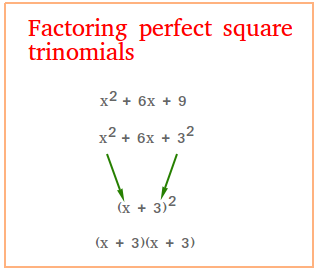Factoring perfect square trinomials
Before we explain the straightforward way of factoring perfect square trinomials, we need to define the expression perfect square trinomial.

Whenever you take the square of a binomial or multiply a binomial by itself twice, the resulting trinomial is called a perfect square trinomial.
The resulting perfect square trinomial is the square of the first term + two times the product of the two terms + the square of the third term (last term).
For example, (x + 1) × (x + 1) = x2 + x + x + 1 = x2 + 2x + 1 and x2 + 2x + 1 is a perfect
square trinomial.
Another example of perfect square trinomial is (x − 5) × (x − 5)
(x − 5) × (x − 5) = x2 + -5x + -5x + 25 = x2 + -10x + 25 and x2 + -10x + 25 is a perfect square trinomial.
A model to keep in mind when factoring perfect square trinomials
Now, we are ready to start factoring perfect square trinomials and the model to remember when factoring perfect square trinomials is the following:
a2 + 2ab + b2 = (a + b)2 and (a + b)2 is the factorization form for a2 + 2ab + b2
Notice that all you have to do is to use the base of the first term and the last term. You do not need to do anything with the middle term of the trinomial or 2ab.
In the model just described, the first term is a2 and the base is a and the last term is b2 and the base is b.
Put the bases inside parentheses with a plus between them (a + b)
Raise everything to the second power (a + b)2 and you are done.
Notice that I put a plus between a and b. You will put a minus sign if the second term is negative!
What if the sign of the middle term is negative?
a2 + -2ab + b2 = (a − b)2
Remember that a2 − 2ab + b2 = a2 + -2ab + b2 because a minus is the same thing as adding the negative ( − = + -)
So, a2 − 2ab + b2 is also equal to (a − b)2
More examples showing how to factor trinomials
Example #1:
Factor x2 + 2x + 1
Notice that x2 + 2x + 1 = x2 + 2x + 12
Using x2 + 2x + 12, we see that the first term is x2 and the base is x; the last term is 12 and the base is 1.
Put the bases inside parentheses with a plus between them (x + 1)
Raise everything to the second power (x + 1)2 and you are done.
Example #2:
Factor x2 + 24x + 144
But wait! Before we continue with more exercises, we need to establish something important when factoring perfect square trinomials.
How do we know when a trinomial is a perfect square trinomial?
This is important to check this because if it is not, we cannot use the model described above. Think of checking this as part of the process when factoring perfect square trinomials.
Start the same way you started example #1:
Notice that x2 + 24x + 144 = x2 + 24x + 122
Using x2 + 24x + 122, we see that the first term is x2 and the base is x; the last term is 122 and the base is 12.
Now, this is how you check if x2 + 24x + 122 is a perfect square
If 2 times (base of first term) times (base of last term) = second term, the trinomial is a perfect square.
If the second term is negative, check using the following instead.
-2 times (base of first term) times (base of last term) = second term.
Since the second term is 24x and 2 × x × 12 = 24x, x2 + 24x + 122 is a perfect square trinomial and we factor like this.
Put the bases inside parentheses with a plus between them (x + 12)
Raise everything to the second power (x + 12)2 and you are done.
Example #3:
Factor p2 + -18p + 81
Notice that p2 + -18p + 81 = p2 + -18p + 92
Using p2 + -18p + 92, we see that the first term is p2 and the base is p; the last term is 92 and the base is 9.
Since the second term is -18p and -2 × p × 9 = -18p, p2 + -18p + 92 is a perfect square trinomial and we factor like this.
Put the bases inside parentheses with a minus between them (p − 9)
Raise everything to the second power (p − 9)2 and you are done.
Example #4:
Factor 4y2 + 48y + 144
Notice that 4y2 + 48y + 144 = (2y)2 + 48y + 122
Using (2y)2 + 48y + 122, we see that the first term is (2y)2 and the base is 2y; the last term is 122 and the base is 12.
Since the second term is 48y and 2 × 2y × 12 = 48y, (2y)2 + 48p + 122 is a perfect square trinomial and we factor like this.
Put the bases inside parentheses with a plus between them (2y + 12)
Raise everything to the second power (2y + 12)2 and you are done.
I hope the process illustrated above when factoring perfect square trinomials was easy to follow. Any questions? Send me an email here.